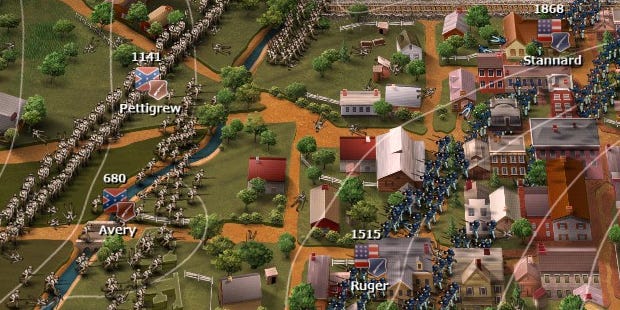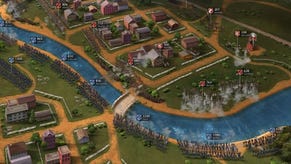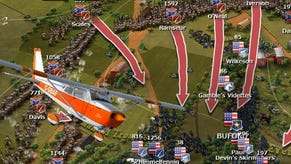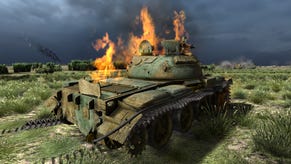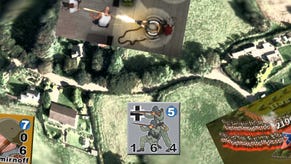The Flare Path: Ultimate General Knowledge
Simulation & Wargame Blather
“My favourite game of 2016? Unquestionably, Ultimate General: Austerlitz. Game-Labs spectacular turnless wargame series has been edging towards Greatness for a couple of years now, and finally took the VL in September. The flaws that tarnished the original release (Ultimate General: Gettysburg) are now distant memories. It's hard to believe I once grumbled about annoying cannon combat, glaring GUI gaps, and an unexpected lack of challenge.”
The Flare Path, January 6, 2017.
Ultimate General: Gettysburg is a very likeable fellow. Approachable, attractive, and frequently mesmerising, he manages to make most contemporary wargames look ugly, awkward, and expensive. Units are marshalled with intuitive arrow drags. Formation choices are automatic. Over in less than 30 minutes, engagements never outstay their welcome. Nine different flavours of unscripted AI and a clever dynamic campaign system ensure no two Battles of Gettysburg are identical.
What's disappointing is that Nick Thomadis and chums have bullwhipped their debut project out of Early Access before addressing shortcomings like the bothersome battery management.
For all intents and purposes, there are only three types of unit in the game. Thanks to inscrutable LoS and unhelpful friendly AI, one of those types - the artillery battery - is far harder to utilize than it should be. In attack especially, you will spend an inordinate amount of time pushing cannons to and fro in the hope of finding good firing positions. Frequently, spots that look promising turn out to be hopeless. Clicking on a desired target then trusting artillerymen to find the closest in-LoS location would seem to be the obvious solution (perhaps with a safeguard to halt the battery if the target moves a significant distance before LoS is established). Given the TacAI sophistication evident elsewhere, it seems odd Game-Labs haven't endowed their cannoneers with more common sense.
Communicating the scale and spectacle of a typical UGG battle with a 620-pixel-wide screenshot is almost impossible. I found myself reminded of a local museum exhibit rather than other digital battle fare, on seeing the game's extraordinary elephant for the first time. Watching as lines of tiny blue and grey figures manoeuvre, collide, and disintegrate, you won't care a jot that Game-Labs have gone with sprite-based rather than polygonal soldiery. What might disappoint is the dev's apparent unwillingness to compromise their wonderful visuals with potentially useful unit icons.
While you can see at a glance how many men are in each of your brigade-sized units, quickly assessing which sections of your line are weary or wavering, fighting fit or fired-up, is much harder. Are the Irish Brigade ready to rejoin the fray? Are the Louisiana Tigers still tigerish? Should I lead my assault with Lane's, Gordon's or Mahone's men? For crucial information like this, you've no option but to painstakingly click on individual formations and read the info panel that pops up in the top left corner of your screen.
Considering designer Nick 'DarthMod' Thomadis's passion for and track record in AI coding, one of the last things I expected to find in UGG was uncompetitive opposition. Right now it doesn't seem to matter much which side you select and which of the nine AI personalities you choose as a foe, losing the Battle of Gettysburg isn't easy.
Initially you may accidentally scupper yourself once or twice by opting for cautious engagement options on the campaign scenario selection screen (Battle results determine scenario choices within the campaign). On the battlefield however, glory is remarkably easy to come by.
It's weird. AI adversaries feel competent. Ignore the odd reckless commander and cannon manoeuvre, and they attack and defend convincingly. They form lines, flank, and focus on weak points well enough. What they struggle to do is win. I suspect the dynamism and flexibility of the campaign engine and the carry-over of unit losses may be part of the issue. Maul the enemy early on, and he struggles to recover.
Happily, after twenty-four hours of tussles, winning has yet to lose its sparkle, and circumstances and code still conspire to produce the odd nailbiter and defeat. The timely arrival of a single battery or the canny repositioning of one general (represented here as TW style morale boosters) can decide a delicately poised scrap. The temptation to try for every Victory Location on a map (the game splits the historical battlefield into several overlapping sections) is hard to resist at times and can invite disaster if succumbed to.
I've yet to try multiplayer or explore the 90+ scenarios in the custom battles folder. As I understand it, the latter are the building blocks of the campaign, so are probably best experienced in that context. With cannon employment fiddly and no option to issue orders while paused in MP, the prospect of sentient opposition isn't particularly appealing at the moment.
Overlooking UGG's relatively minor weaknesses will be a lot be easier if you're unfamiliar with the classic it most resembles and the series that many grogs now rely on for Blue & Gray battle simulation. Those that know and love Sid's 1997 masterpiece may find themselves wondering why Game-Labs didn't purloin a few more of SMG's excellent features. UGG's bendable movement arrows are a doddle to daub, but the fact you can't fine-tune unit facing at a destination means they are arguably less useful than their SMG equivalents. Topography is easier to read in the old-timer, briefings are more atmospheric, and - thanks to a replay facility and entertaining unit-highlighting de-briefings - post-combat contemplation is more satisfying too.
Generals arriving from Scourge of War will, I suspect, struggle to come to terms with UGG's tactical simplicity. With no formation options and no need to worry about delayed or distorted orders, the game basically boils down to applying appropriate pressure in appropriate spots at appropriate times. In essence, you're just bawling 'Go there!' over and over again. There are 'charge' and 'hold' orders - you may manually select targets for units, and ammo types for artillery - but, right now, use of such subtleties isn't strictly necessary.
Without perusing your book/game library and personally checking your face for a Longstreet-inspired chin thicket, I can't say for sure whether you will enjoy Ultimate General: Gettysburg. With its staggeringly spectacular scraps, simple controls, and lively (if not especially competitive) AI presently harassed by a skirmish line of small yet annoying flaws, disappointment is highly unlikely, but not completely unthinkable.
**************************
The Flare Path Foxer
Roman tends to shred foxers that remain unsolved for more than two weeks. If you can't see the next image, then, chances are, it's been turned into chaff and is currently hiding Hetzer, the office hamster.
To prevent today's puzzle ending up as rodent bedding, identify the theme connecting the seven collage components below. Previous themes have included Louis XIV, Cobras, Quartz, Sherlock Holmes, Vatican City and Monopoly.
All answers in one thread, please.
